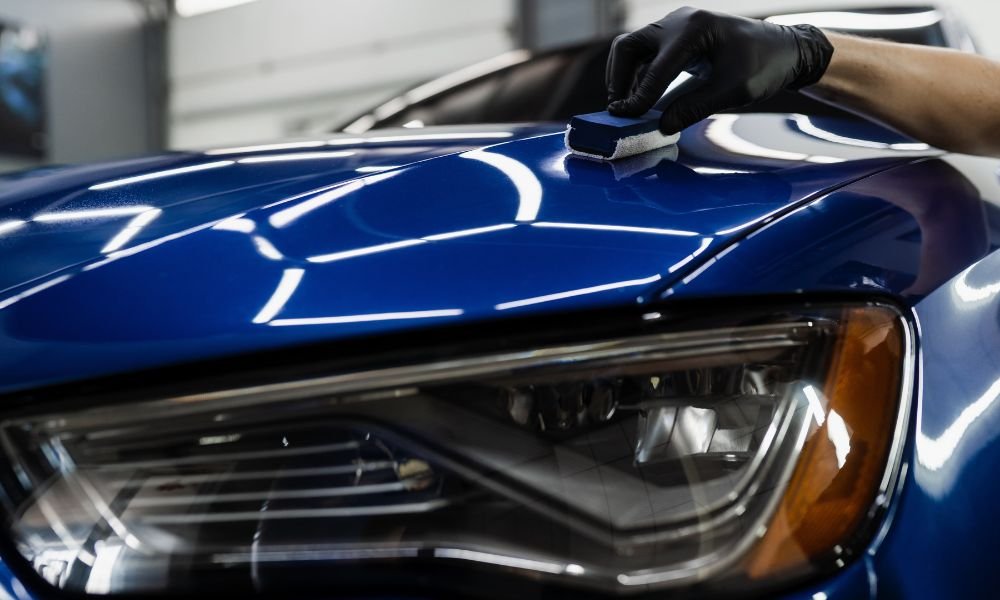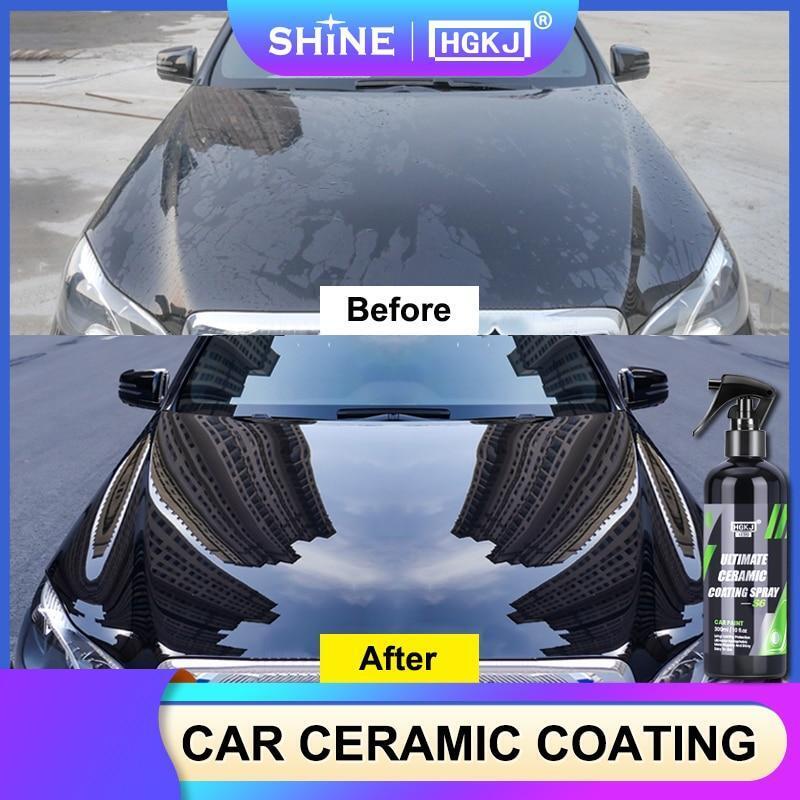A buyer’s guide to finding affordable Ceramic Coating Newark
Exploring the Science Behind Car Ceramic Coating and Its Safety Characteristics
The science of car ceramic coating provides a remarkable research in sophisticated auto defense. Made up primarily of silicon dioxide and polymers, these finishings form a robust bond with automobile paint. This interaction boosts toughness against ecological dangers while offering hydrophobic advantages. Nonetheless, the intricacies of exactly how these layers work and their lasting advantages remain less comprehended. Unboxing these information reveals why ceramic finishings are coming to be a recommended option for lorry treatment
What Is Ceramic Coating?
Ceramic coating is a fluid polymer that chemically bonds to the surface of an automobile's paint. This advanced safety layer enhances toughness and supplies superior resistance to ecological factors. Unlike traditional wax or sealers, which provide short-term security, ceramic coverings develop a durable shield that can stand up to severe conditions such as UV rays, acidic contaminants, and severe weather. When used properly, the coating creates a hydrophobic surface area, creating water to grain and slide off, which assists in maintaining the car's sanitation. In addition, it provides enhanced gloss and depth to the paint, making the vehicle show up even more refined and lively. The application process usually includes extensive surface area prep work, including cleaning and sprucing up, to assure peak bonding. Consequently, ceramic coverings are becoming increasingly preferred among car lovers and those seeking to protect their financial investments, assuring to preserve the automobile's visual appeal while lowering the frequency of upkeep.
The Make-up of Ceramic Coatings
The intricate solution of ceramic finishings largely contains silicon dioxide (SiO2), which is originated from all-natural sources like quartz and sand. This essential part gives the foundation for the coating's toughness and protective high qualities. In enhancement to SiO2, ceramic finishings typically consist of numerous polymers and ingredients that improve adhesion, flexibility, and resistance to ecological aspects. These compounds function synergistically to produce a robust barrier versus impurities such as dirt, chemicals, and UV rays.Furthermore, some formulations incorporate titanium dioxide (TiO2) or other nanomaterials, which can boost the coating's hydrophobic homes, resulting in enhanced water repellency. The specific structure can differ significantly amongst manufacturers, affecting efficiency and long life. Inevitably, the combination of these aspects culminates in a safety layer that not just enhances the aesthetic appeal of lorries however also serves to lengthen their life-span by shielding the surface from potential damage.
Exactly How Ceramic Coatings Work
Recognizing exactly how ceramic coverings function involves discovering their chemical make-up, which adds to their protective qualities. The application procedure is important for attaining optimal results, while long life and durability elements establish the coating's performance in time. Together, these elements highlight the benefits and efficiency of ceramic finishings for automobile protection.
Chemical Composition Explained
While numerous car proprietors seek resilient security for their vehicles, the chemical structure of ceramic coatings plays an important duty in their performance. These coatings mostly contain silicon dioxide (SiO2), which is derived from all-natural minerals. This substance creates a solid bond with the vehicle's paint, producing a resilient, safety layer. Additionally, many ceramic coatings have titanium dioxide (TiO2), enhancing their hydrophobic properties and resistance to UV rays. The presence of polysiloxanes can further enhance adaptability and durability. With each other, these elements add to the coating's ability to drive away water, dirt, and contaminants, while additionally giving a high-gloss coating. Recognizing this chemical foundation assists car owners appreciate the durable defense offered by ceramic coatings.
Application Refine Review
Using ceramic coverings includes a meticulous procedure that ensures suitable bonding and protection for the car's surface. Thorough cleaning and purification of the car's exterior are performed to remove dust, grime, and previous waxes. This action verifies that the surface is devoid of pollutants that could prevent adhesion. Following this, the paint is frequently polished to enhance quality and remove any kind of imperfections. When prepared, the ceramic coating is used in small sections using an applicator pad, permitting consistent protection. The coating is after that entrusted to cure, developing a strong chemical bond with the surface area. Proper healing times and conditions are vital, as they verify the coating attains its maximum performance and safety qualities.
Longevity and Toughness Aspects
Ceramic finishings are developed to offer resilient security via their innovative chemical composition, which produces a robust barrier versus ecological pollutants. The durability of these layers is influenced by factors such as the thickness of the application, the high quality of the item, and the conditions under which the automobile is subjected. Top notch ceramic finishings can last a number of years, withstanding scratches, UV rays, and chemical stains. Correct upkeep, including routine cleaning and routine reapplication, can better enhance longevity. Furthermore, ecological elements like climate and exposure to pollutants can influence the lifespan of the coating. On the whole, when applied and preserved appropriately, ceramic finishes provide outstanding durability, making them a popular selection for car lovers seeking to maintain their car's look.
Hydrophobic Residences and Water Repellency
Hydrophobic residential properties are a trademark of high quality car ceramic finishes, substantially boosting the car's surface area performance. These layers create a molecular bond with the car's paint, resulting in a surface that fends off water successfully. When water comes right into contact with a ceramic-coated surface, it beads up and rolls off, decreasing the amount of fluid that continues to be on the paint. This habits not just contributes to an aesthetically pleasing look yet additionally minimizes the accumulation of impurities such as dirt, grime, and roadway salts.The enhanced water repellency results in easier cleaning and maintenance, as much less initiative is needed to get rid of unwanted compounds. Furthermore, the hydrophobic nature of ceramic layers aids in stopping water areas, which can mar the finish of uncoated surface areas. Overall, the consolidation of hydrophobic properties in ceramic finishings plays a vital duty in maintaining the Going Here car's immaculate appearance while streamlining upkeep.
Defense Against Scratches and UV Damages
Car ceramic finishings provide significant defense versus scrapes and UV damages. The scratch resistance mechanism develops a sturdy layer that soaks up effects, while the UV shielding benefits help keep the automobile's paint integrity gradually. With each other, these features add to a longer-lasting and visually attractive finish.
Scratch Resistance System
Making use of innovative innovation, ceramic finishings supply a durable guard versus scrapes and UV damages, boosting the long life and look of car surface areas. The scrape resistance mechanism of these layers is attributed to their one-of-a-kind molecular framework, which creates a durable bond with the vehicle's paint. This bond produces a hard, protective layer that can soak up impacts and withstand abrasions. In addition, the smooth surface area of the coating minimizes rubbing, making it difficult for contaminants to adhere and cause scratches. The chemical make-up of ceramic layers often consists of nanoparticles that reinforce the safety layer, further boosting its resilience. Cars treated with ceramic coverings show markedly boosted scrape resistance compared to traditional wax or sealers, making certain a beautiful surface over time.
UV Shielding Advantages
The safety qualities of ceramic layers expand beyond scratch resistance to consist of substantial UV protecting advantages. These finishings produce a robust obstacle that shows dangerous ultraviolet rays, guarding the vehicle's paint and underlying products. Prolonged exposure to UV radiation can lead to fading, oxidation, and deterioration of the paint coating. By including ceramic coverings, vehicle proprietors can efficiently reduce these threats, click protecting the aesthetic appeal and integrity of their autos. Additionally, the UV obstructing homes add to boosted longevity, reducing the regularity of repainting and maintenance. Ultimately, the integration of ceramic coatings offers a complete option for shielding vehicles from the damaging effects of sun direct exposure, guaranteeing a continual, vibrant appearance over time.
The Long life and Maintenance of Ceramic Coatings

Often Asked Inquiries
Can Ceramic Coating Be Applied to Any Kind of Vehicle?
Ceramic coating can be used to numerous sorts of cars, consisting of automobiles, trucks, and bikes. However, surface area prep work and compatibility with details materials are important for ideal bond and efficiency of the coating.
Just How Much Does Ceramic Coating Generally Price?
Ceramic coating commonly costs between $500 and $2,000, relying on variables such as car dimension, coating quality, and expert application. The investment can supply long-lasting protection and enhance the car's appearance in time.

Is Specialist Application Needed for Best Outcomes?
The necessity of expert application typically relies on desired results. Experts generally guarantee correct surface area preparation and application techniques, bring about perfect bonding and longevity of the coating, which may be testing for unskilled people to achieve.
Can Ceramic Coatings Be Removed or Fixed?
Ceramic finishes can be gotten rid of or repaired, though the procedure may need particular solvents or strategies - Ceramic Coating Newark. Appropriate elimination is important to stay clear of damages to the underlying surface, emphasizing the significance of specialist assistance for ideal results
Just How Does Porcelain Coating Contrast to Traditional Wax?
The contrast in between ceramic coating and standard wax exposes that ceramic finishes offer premium longevity, improved defense versus environmental pollutants, and longer-lasting sparkle, while wax requires a lot more regular application and offers much less total resistance to damages.